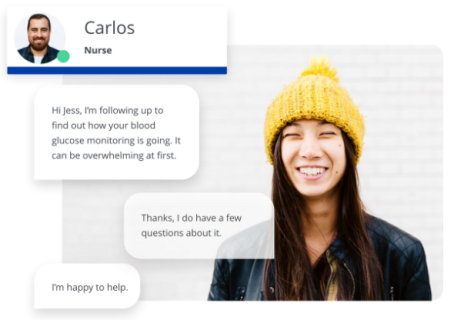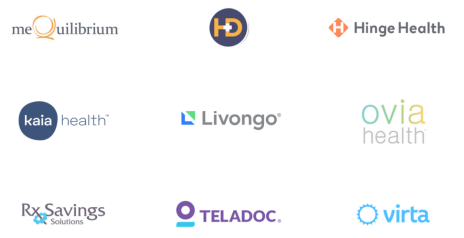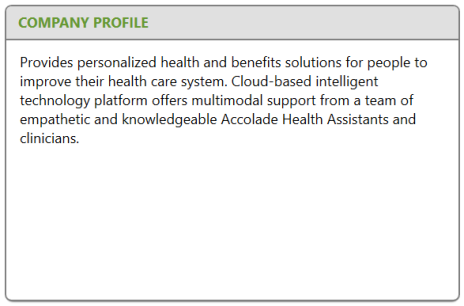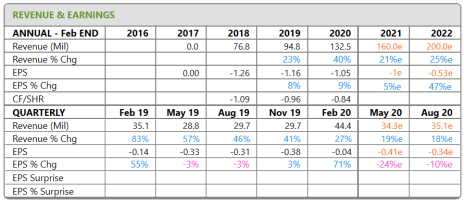This month we’re jumping into a new IPO that’s following in the footsteps of Livongo and Teladoc, bringing an innovative digital health solution to the masses.
As with those firms, this company sells solutions to companies, but it is the end consumer that uses the products, which are aimed at improving engagement and health outcomes while reducing costs.
With limited history as a public company, an earnings report coming next week, and the recent news that Livongo and Teledoc will merge, I expect shares of this company will be somewhat volatile. Please be sure to average in. We are starting with BUY A HALF rating today.
All the details are inside this month’s Issue. Enjoy!
Cabot Small Cap Confidential 255
[premium_html_toc post_id="211723"]
The Big Idea
To say that the U.S. healthcare system is complicated, confusing, and expensive would be a colossal understatement.
One could argue that “system,” defined as an organized framework or method, isn’t a very good term at all. Perhaps “landscape,” which encompasses both existing and transitory elements, is better.
In any event, there is ample room for improvement. One of the ways to move in the right direction is to use digital health services to make it easier for millions of employees to understand what their healthcare options are, how to pursue the best care for them, and to control costs.
Just understanding what to do in the first place is a major challenge. Many employees of large companies have access to care, but don’t fully grasp how to go about getting it.
Industry analysts believe roughly two-thirds of employees are so overwhelmed with the volume of fragmented information they get about company benefits that they just ignore it all.
Even use of telemedicine is reported to be only roughly 10% among companies with 500 employees! That number is likely going up due to COVID-19, which may be one silver lining of the pandemic, but still, utilization of benefits has been woefully low.
This is frustrating for both employees and companies, and probably doctors too.
Employees are contributing more to healthcare costs than ever (the average premium is up 54% over the last decade), while not even using the full range of benefits that are available, getting billed for services that they thought were covered but are not.
Employers are often paying more than $10,000 per employee and dealing with frustrated or absent employees who are trying to navigate the “system.”
Meanwhile, costs are rising by an average of 6% annually (well above the rate of inflation) and there is little evidence to suggest people are getting better care.
One of the trends gaining favor to address these issues is that companies are playing a larger role in healthcare. In smaller companies this often involves strategies to increase employee engagement and working with their insurance carrier to promote timely services, such as maternity management, flu shots and care of chronic conditions like asthma.
Many larger companies are simply moving to a self-insured model, also known as ASO (Administrative Services Only) plans. In this model the company pays for health benefits themselves.
In 2019 roughly 80% of companies with over 500 employees were self-insured. This means a very large target market for digital health solutions.
In fact, when adding in the slightly smaller companies that are looking for digital health services, as well as other markets (Federal, Medicare Advantage, etc.) the total market for digital health services aimed at self-insured companies approaches $15 billion.
Today we’re investing in a newly-public company that’s a pure play on digital health solutions for the ASO market.
The company has only been public for about a month, so there is likely to be significant price movement in the stock in the near-term (both up and down). But with a clear and present need for its solutions and rising investor appetite for digital health companies we’re going to jump in early.
The Company
Accolade (ACCD) is a digital healthcare company with a user-friendly platform that helps members navigate the healthcare system, make better decisions for their healthcare and benefits needs, and control costs.
It achieves this through use of cloud-based technology, data-driven insights and the support of empathetic and experienced Accolade Health Assistants and Clinicians. Accolade does not provide care.
The company’s target customers are enterprise-scale (1,000+ employees) companies with self-insured healthcare programs, also known as ASO (Administrative Services Only) plans. These employers, which collectively spend $15 billion to cover roughly one-third of insured Americans, use their own funds to provide health benefits to their employees.
Those employees and their families (members) benefit from Accolade’s platform approach, which combines a personalized healthcare management team with sophisticated machine learning algorithms, rules engines and mobile apps.
The goal of the founders, Michael Cline and Tom Spann, was simple: to improve the healthcare experience for patients so they get the right answer the first time.
The results for members are impressive. Member engagement is over 50%. Over the last three years Accolade has achieved a Net Promoter Score (NPS) of 60. That compares favorably to a median NPS of 14 for health insurance companies.
Cost savings for employers are meaningful too. Accolade customers typically save around 4% on their healthcare spend in the first year of membership. That savings often increases to 10% per year, or more.
Despite a compelling value proposition and easy-to-use platform, Accolade is still early in its growth curve. Revenue in fiscal 2020 of $132 million was up 40%, which implies the company has nabbed less than 1% of its addressable market.
Adding just a few large customers per year should mean revenue growth could easily top 20%. It could be far better, however. Management is expanding Accolade’s potential market by pursuing opportunities in slightly smaller companies, into Federal markets, and into the Medicare Advantage market.
Altogether, Accolade is now going after more than $16 billion in self-insured spending that covers nearly 160 million lives.
The company currently has just over 50 customers spanning the media, technology, financial services, transportation, energy, and retail sectors. Notable enterprise customers include Lowe’s, Comcast, United Airlines and American Airlines.
Accolade has a market cap of $1.8 billion and is based in Seattle, Washington, was founded in 2007, and just went public on July 2. With the stock acting strong in the wake of the Teledoc (TDOC) and Livongo (LVGO) proposed merger we are starting with a half position.
Products & Platform
Accolade’s founders believed that the best way to achieve their mission of “empowering people through expertise, empathy, and technology to make the best decisions for their health and well-being,” while simultaneously controlling costs, is to give consumers the tools to make better, data-driven healthcare and benefits-related decisions, delivered through a user-friendly platform that spans the entire healthcare ecosystem.
So that’s what they built.
Accolade’s platform merges Accolade data with external data to simplify and streamline the healthcare and benefits experience by making guidance available to members via phone, mobile app and web portal whenever, and wherever, they need it.
There are three main components of the platform:
Accolade Health Assistants: The main point of contact for members, Health Assistants provide data-informed, personalized health and benefits support, as well as guidance for using the Accolade platform.
Clinicians: After speaking with a Health Assistant members progress to a nurse (average 16+ years experience), who then works with other Accolade Clinicians. Those clinicians include physician medical directors, pharmacists, behavioral health specialists and/or women’s health specialists, who help figure out the member’s care needs. End results range from identifying quality and cost-efficient providers, assisting with visit preparation, medication consultation and conflict resolution, and complex case management.
Accolade has three product offerings for customers to choose from.
The most comprehensive solution, Accolade Total Health and Benefits, has the most customers and accounts for the bulk of revenue. Recently, as Accolade realized there were opportunities in smaller companies, management split that solution into two new, lower-cost offerings that are somewhat easier to implement – Accolade Total Benefits and Accolade Total Care.
Accolade Total Benefits
Accolade Total Benefits is for companies with low employee adoption of healthcare and benefits programs and which would like to keep their existing insurance carrier. This solution aims to improve member adoption by making it easy to find, understand and act on benefits, while also providing the human support (Accolade Health Assistants and nurses) needed to fully understand all that’s available to them.
Accolade Total Care
Accolade Total Care is also for companies that don’t want to mess with their existing carrier arrangements, but would like to help guide employees and their dependents to the best care options and providers within the scope of their benefits. The solution identifies appropriate doctors, schedules appointments, assigns Accolade nurses, and prepares members for their visits.
Accolade Total Health and Benefits: Accolade’s full suite of solutions offers the benefits of both Accolade Total Benefits and Accolade Total Care, while also adding comprehensive population health management tools. The solution is for companies that are willing to change up their previous carrier arrangement and authorize Accolade to deliver member and provider services.
With this solution Accolade becomes embedded in the consumption of healthcare benefits, offering many clinical programs, including treatment decision support, chronic care, maternity management, complex case management and behavioral health support. Accolade sits between the member and the provider, offering strategic guidance and transactional efficiencies on behalf of both parties.
Accolade COVID Response Care
Most recently Accolade unveiled COVID Response Care to help support employers through the steps of testing, care for sick employees, contact tracing, and return to work clearance. The solution is based on CDC-guidelines and has been evolving based on input from existing customers.
Health & Benefits Ecosystem
Accolade helps customers build the right ecosystem for them by integrating with a curated list of third-party vendors that have been pre-approved by Accolade and which can be purchased through the platform, such as Teladoc, Livongo and Ovia Health. Accolade handles all the contracting, billing and management.
Growth Initiatives
Land New Enterprise-Scale ASO: Accolade only needs to land a couple very large customers a year to generate growth north of 20%. If it adds several more, growth could accelerate.
Expand into Mid-Market ASO Employers, Then Upsell: In 2019 Accolade introduced entry-level solutions for companies that don’t want to disrupt their current insurance carrier relationship. These products, Accolade Total Care and Accolade Total Benefits, only account for around 5% of revenue but should grow to a more meaningful amount, while driving higher profit margins. Accolade can then upsell to these customers over time.
Expand into Federal Programs: Accolade won a pilot deal with a Defense Health Agency (Tricare) in January to manage 75,000 lives. This program could be expanded to roughly 9 million lives if successful, and help pave the way to more Federal programs, which could mean over 10 million more lives.
Humana and Other Medicare Advantage Market Opportunities: Accolade recently inked a deal with Humana for its commercial offering. This could be expanded to Medicare Advantage and also help Accolade secure deals with other insurers (besides United and Aetna, who have their own solutions).
The Business Model
The company employs a business-to-business-to-consumer (B2B2C) business model that focuses on selling services to employers with ASO plans, though a strategy to move down market to slightly smaller companies is occurring now. While Accolade sells to companies, it is the employees and their dependents who actually use the services. This business model is somewhat similar to that of digital healthcare companies Livongo (LVGO) and Teladoc (TDOC). Accolade’s subscription revenue model, based on recurring per-member-per-month (PMPM) fees, means significant visibility into the future as the typical contract is for a three-year term. Gross dollar retention has been in the 95% to 100% range in recent years.
The Bottom Line
As a newly public company Accolade has no public reporting history. Its fiscal year ends on February 28, so the upcoming quarterly report on August 13 (next Thursday) will be for the first quarter of fiscal 2021.
The company’s S-1 filing shows that revenue grew by 23% to $95 million in 2018 and by 40% to $132.5 million in 2019. Accolade is not profitable and lost $1.05 per share last fiscal year. Consensus estimates suggest Accolade should grow revenue by around 21% this year (fiscal 2021), 25% next year (fiscal 2022) and 30% in fiscal 2023. However, if things go well it is possible we could see growth in the 25% to 40% range over the next three years.
The company likely won’t be profitable for several years, and investors will be looking for management to make progress improving margins by implementing more cost-saving technologies, improving the process of onboarding new clients and growing lower-touch services (Total Care and Total Benefits), which currently only account for around 5% of revenue. Estimated EPS is -$1.05 in 2021 and $-0.50 in 2022.
Risk
Exposure to Airline Customers: American Airlines and United Airlines account for roughly 18% of revenue. This sector has been hit hard from the Covid-19 pandemic and there will likely be some reducing in airline workforces as a result. That said, this exposure is known so it could be factored into the share price.
Customer Concentration: As a small company with small market share (under 1% of addressable market) in an industry catering to large employers, Accolade has significant customer concentration. The top five clients account for roughly 65% of revenue. Disruptions in the current client base could have a meaningful impact on revenue. That said, Comcast, which is one of the top customers, is also an investor.
Health Insurer Competition: Both Aetna and UnitedHealth have similar product offerings on their platforms and could pose a risk to Accolade’s growth potential. But other insurers see Accolade as a way to help them. For example, Humana has recently invested in Accolade ($20 million) and is a strategic partner.
Lack of Profitability: Like many startups Accolade is in growth mode and not profit mode. At the moment many investors are comfortable with this type of company but if growth slows or the outlooks dims for any reason it will be harder to look past the lack of profitability.
Competition
Accolade competes with companies that provide managed care as well as those with solutions targeted at a certain market. Notable competitors include UnitedHealth, Aetna, BlueCross BlueShield, ArmadaHealth, ConsumerMedical, BenefitExpress, Amino, Health Advocate, Castlight Health and Amino.
The Stock
Trading Volume: Technically speaking, ACCD’s average daily volume is 820,000 shares. But that’s skewed higher because of trading volume following the IPO. Since July 16 ACCD has traded less than 500,000 shares, and most days have seen the stock trade between 100,000 and 300,000 shares.
Historical Price: ACCD came public at 22 and closed up 35% the first day, though intra-day the stock spiked to nearly 37. Since then the general trend in closing prices has been up, though the stock has been somewhat volatile on both an intra-day and day-to-day basis. ACCD spent most of July trading between 30 and 35, with a few spikes above the upper end of the range. Shares entered this week trading near 33 then jumped as high as 38.7 yesterday before closing at 38.
Valuation & Projected Price Target: ACCD could easily trade at a premium valuation given that investors have been willing to pay up for other digital healthcare stocks with rapid growth, like TDOC and LVGO. Assuming management delivers on its growth plans ACCD could trade up to near 60 in the next 12 months. That implies a 2021 EV/Revenue multiple near 15.5.
Buy Range: This is a recent IPO and a small cap so the stock will likely be volatile for several months. Additionally, earnings come out next Thursday, August 13. Be sure to average in! Our near-term buy range (ahead of earnings) is 30 to 40. We will reevaluate after earnings. We are starting with a half position. BUY A HALF
The Next Event: First-quarter fiscal 2021 earnings come out next Thursday, August 13.
Note on Financials: Due to an anomaly
Updates on Current Recommendations
| Stock Name | Date Bought | Price Bought | Price on 8/6/20 | Profit | Rating |
| Accolade (ACCD) | New | — | 37.97 | — | Buy a Half |
| AppFolio (APPF) | 6/2/17 | 30.45 | 162.92 | 435% | Hold |
| Arena Pharmaceuticals (ARNA) | 2/2/18 | 38.93 | 64.43 | 66% | Buy |
| Avalara (AVLR) | 2/1/19 | 40.05 | 133.44 | 233% | Hold |
| Cardlytics Inc (CDLX) | 9/6/19 | 37.97 | 66.08 | 74% | Hold |
| Everbridge (EVBG) | 12/2/16 | 15.51 | 150.28 | 869% | Buy |
| EverQuote (EVER) | 6/7/19 | 11.69 | 41.69 | 257% | Buy |
| Fiverr Intl (FVRR) | 3/5/20 | 32.32 | 122.87 | 280% | Hold 3/4 |
| Goosehead Insurance (GSHD) | 9/7/18 | 31.35 | 109.16 | 248% | Hold 3/4 |
| Inspire Medical (INSP) | 10/4/19 | 58.54 | 108.89 | 86% | Hold |
| Karyopharm Therapeutics (KPTI) | 5/7/20 | 19.49 | 15.76 | -19% | Buy |
| Palomar Holdings (PLMR) | 6/4/20 | 82.34 | 98.84 | 20% | Buy |
| Q2 Holdings (QTWO) | 4/1/16 | 23.81 | 99.47 | 318% | Buy |
| Repay Holdings (RPAY) | 7/2/20 | 25.04 | 24.49 | -2% | Buy |
| Repligen (RGEN) | 11/2/18 and 12/31/18 | 59.19 | 155.88 | 163% | Buy |
Please email me at tyler@cabotwealth.com with any questions or comments about any of our stocks, or anything else on your mind.
Glossary
Buy means accumulate shares at or around the current price.
Hold means just that; hold what you have. Don’t buy, or sell, shares.
Sell means the original reasons for buying the stock no longer apply, and I recommend exiting the position.
Sell a Half means it’s time to take partial profits. Sell half (or whatever portion feels right to you) to lock in a gain, and hold on to the rest until another ratings change is issued.
The next Cabot Small-Cap Confidential issue is scheduled for September 3, 2020.
Cabot Wealth Network
Publishing independent investment advice since 1970.
CEO & Chief Investment Strategist: Timothy Lutts
President & Publisher: Ed Coburn
176 North Street, PO Box 2049, Salem, MA 01970 USA
800-326-8826 | support@cabotwealth.com | CabotWealth.com
Copyright © 2020. All rights reserved. Copying or electronic transmission of this information is a violation of copyright law. For the protection of our subscribers, copyright violations will result in immediate termination of all subscriptions without refund. No Conflicts: Cabot Wealth Network exists to serve you, our readers. We derive 100% of our revenue, or close to it, from selling subscriptions to its publications. Neither Cabot Wealth Network nor our employees are compensated in any way by the companies whose stocks we recommend or providers of associated financial services. Disclaimer: Sources of information are believed to be reliable but they are not guaranteed to be complete or error-free. Recommendations, opinions or suggestions are given with the understanding that subscribers acting on information assume all risks involved. Buy/Sell Recommendations: All recommendations are made in regular issues or email alerts or updates and posted on the private subscriber web page. Performance: The performance of this portfolio is determined using the midpoint of the high and low on the day following the recommendation. Cabot’s policy is to sell any stock that shows a loss of 20% in a bull market or 15% in a bear market from the original purchase price, calculated using the current closing price. Subscribers should apply loss limits based on their own personal purchase prices.







